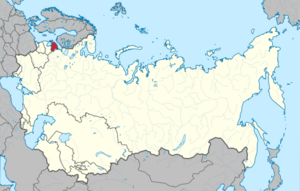Estonian Soviet Socialist Republic facts for kids
Quick facts for kids Estonian Soviet Socialist Republic
Eesti Nõukogude Sotsialistlik Vabariik
|
|
|---|---|
| 1940–1991 | |
 Location of the Estonian SSR (red) within the Soviet Union. |
|
| Anthem | |
| Anthem of the Estonian Soviet Socialist Republic |
|
| Capital | Tallinn |
| Area | |
|
• 1989
|
45,227 km2 (17,462 sq mi) |
| Population | |
|
• 1989
|
1,565,662 |
| • Type | Soviet Socialist Republic |
| Historical era | World War II · Cold War |
|
• Soviet occupation
|
June 16, 1940 |
|
• SSR established
|
21 July 1940 |
| August 9, 1940 | |
|
• Nazi occupation
|
1941 |
|
• Soviet re-occupation
SSR re-established |
1944 |
|
• Estonian Sovereignty Declaration
|
November 16, 1988 |
|
• Singing Revolution
|
1988 |
|
• Disestablished
|
20 August 1991 |
|
• Recognized
|
September 6, 1991 |
The Estonian Soviet Socialist Republic, often called the Estonian SSR or ESSR, was a part of the Soviet Union. It was like a state or province within that larger country. The Soviet government in Moscow controlled how the ESSR was run.
The ESSR was formed on July 21, 1940. This happened after Soviet troops entered Estonia on June 17, 1940. A new government, supported by the Soviet Union, then declared Estonia a Soviet state. On August 9, 1940, the Estonian SSR officially became part of the USSR. Estonia became an independent country again on August 20, 1991.
Contents
How the ESSR Was Formed
The story of the Estonian SSR began before World War II. In 1939, two powerful countries, Nazi Germany and the Soviet Union, made a secret agreement. This agreement, known as the Molotov–Ribbentrop Pact, divided parts of Eastern Europe into "spheres of influence." Estonia was placed in the Soviet Union's sphere.
Soviet Occupation of Estonia
In June 1940, the Soviet Union sent a large number of troops into Estonia. They also demanded that Estonia's government be changed. Soon after, a new government was put in place. This government was controlled by the Soviet Union.
On July 21, 1940, this new government declared Estonia a Soviet Socialist Republic. This meant Estonia was now a communist state, similar to other parts of the Soviet Union. Many Estonians did not agree with this change. However, they had little choice due to the presence of Soviet troops.
Joining the Soviet Union
Just a few weeks later, on August 9, 1940, the Estonian SSR officially joined the Soviet Union. This was a big change for Estonia. It lost its independence and became one of the 15 republics of the USSR.
Life in the Estonian SSR
Life in the Estonian SSR was very different from life in an independent Estonia. The Soviet system brought many changes to how people lived, worked, and thought.
Economy and Society
The Soviet government took control of all businesses and farms. Private ownership was mostly ended. Factories and farms became state-owned. The government decided what would be produced and how it would be distributed.
People's lives were planned by the state. Housing, jobs, and education were all managed by the government. While everyone had access to basic services, there was often a lack of goods and choices.
Culture and Language
The Soviet government promoted communism and Soviet culture. Russian became a very important language, and it was taught in schools. Estonian culture and traditions were still present, but they were often controlled or changed to fit Soviet ideas.
Despite this, Estonians tried to keep their culture alive. Events like the Estonian Song Festival continued. These festivals were huge gatherings where thousands of people sang together. They became important ways for Estonians to express their national identity.
Challenges and Changes
During the Soviet era, many Estonians faced difficulties. There were periods of hardship, especially after World War II. People were sometimes moved from their homes, and some were sent to distant parts of the Soviet Union.
However, there were also developments. Cities like Tallinn grew, and new industries were established. Public transport, like the Tatra T3 trams, became common.
The End of the ESSR
Towards the end of the 1980s, the Soviet Union began to weaken. People in many Soviet republics, including Estonia, started to demand more freedom.
The Singing Revolution
Estonia played a big part in this movement. It was called the Singing Revolution. People gathered in large numbers to sing patriotic songs and demand independence. These peaceful protests showed the world that Estonians wanted their country back.
On November 16, 1988, Estonia declared its sovereignty. This meant it stated its right to govern itself, even while still part of the Soviet Union.
Independence Restored
Finally, on August 20, 1991, Estonia declared its full independence. This was a historic moment. The Estonian SSR officially ended, and the independent Republic of Estonia was reborn. Other countries quickly recognized Estonia's independence, including the Soviet Union itself on September 6, 1991.
Images for kids
-
According to the 23 August 1939 Nazi-Soviet Pact Finland, Estonia, Latvia, Lithuania were divided into German and Soviet "spheres of influence" (German copy)
-
A propaganda poster from the Stalin era. The poster says: "The spirit of the great Lenin and his victorious banner encourage us now in the Patriotic War."
-
Tatra T3 along the Pärnu maantee street in Tallinn on June 26, 1983
-
The blue-black-white flag of Estonia was raised on Pikk Hermann on February 24, 1989.
-
1941 mugshot of kindral Johan Laidoner after his arrest 1940
See also
 In Spanish: República Socialista Soviética de Estonia para niños
In Spanish: República Socialista Soviética de Estonia para niños















